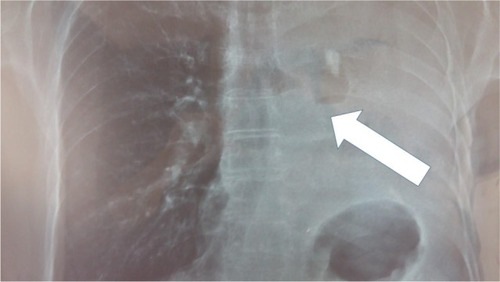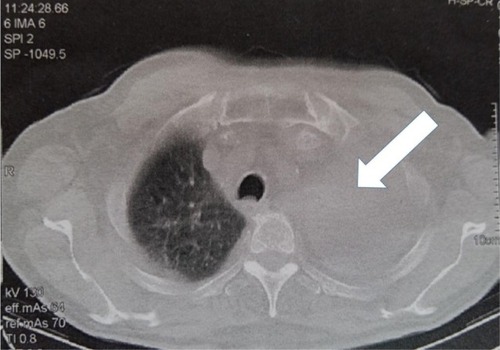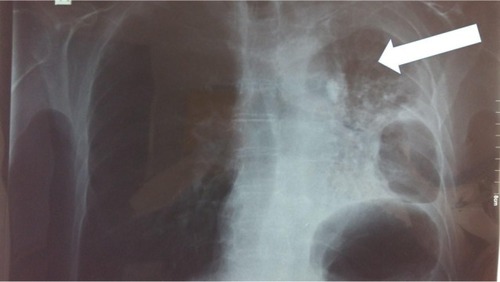Abstract
Introduction
The majority of cases of lung cancer are still diagnosed at a late stage. At this stage, palliative therapeutic options including nonspecific cytotoxic drugs, targeted therapy, or immunotherapy can be utilized. In 2016, immunotherapy was approved in Europe for squamous cell carcinoma and adenocarcinoma. Moreover, afatinib was also approved as second-line therapy for squamous cell carcinoma.
Case report
This article presents a case of a 76-year-old male with squamous cell carcinoma who received nab-paclitaxel as first-line therapy, and his treatment was switched to the tyrosine kinase inhibitor afatinib (40 mg) after disease progression with left lung atelectasis. After receiving afatinib for only 28 days, the atelectasis resolved. No adverse effects were observed from the afatinib therapy.
Discussion
In this case, afatinib 40 mg proved to be an effective alternative treatment for an elderly patient. Treatment choice should be based on the performance status of the patient, cost-effectiveness, and drug treatment guidelines.
Keywords:
Introduction
Lung cancer is most commonly diagnosed at a late stage because of the lack of early symptoms and no reliable screening markers. However, early detection is very important; hence, several authors have proposed specific target groups and techniques for lung cancer screening.Citation1,Citation2 Treatment for stage IV disease could be divided in four groups: 1) nonspecific cytotoxic agents, 2) tyrosine kinase inhibitors (TKIs), 3) immunotherapy, and 4) local therapy (eg, endoscopic debulking techniques, microwave, or radiofrequency).Citation3–Citation6 Nonspecific cytotoxic agents have a limitation because of the drug-related complications in the elderly and those with a compromised performance status. Therapies that target epidermal growth factor receptor (EGFR) and anaplastic lymphoma kinase are currently available. In order to identify these mutations, re-biopsy if indicated or liquid biopsy may be needed to identify a possible mutation.Citation7–Citation13 Immunotherapy was approved in Europe for both squamous cell carcinoma and adenocarcinoma.Citation14 Immunotherapy utilized as maintenance therapy is actively being investigated.Citation15 The novel immunotherapy pembrolizumab has been approved as first-line treatment for non-small cell lung cancer (NSCLC) based on the expression of anti-PD-1/PD-L1 antibodies.Citation16 The major issue with immunotherapy is the cost; however, since immunotherapy is becoming a “targeted” therapy, it will certainly become a first choice of treatment for lung cancer. TKIs still remain the targeted therapy of choice where possible with novel agents being already on the market such as AZD9291 osimertinib. Further experimentation with TKIs has identified new treatment options such Giotrif® (afatinib), which is approved for second-line treatment without the patient expressing an EGFR mutation.Citation17,Citation18 Afatinib is a second-generation protein kinase inhibitor that irreversibly inhibits EGFR.Citation19
Case report
A 76-year-old male was diagnosed with squamous cell carcinoma from a central mass in the left stem bronchus. The patient had 150 pack-years of tobacco abuse and no distant metastasis, but he could not undergo surgery because of the location of the central mass. He was offered and agreed to receive nab-paclitaxel as first-line treatment because of his age and performance status. After four cycles of therapy, atelectasis was observed consistent with disease progression on chest imaging and afatinib 40 mg was suggested to the patient, which he agreed upon and initiated. The patient performance status was Eastern Cooperative Oncology Group (ECOG) 0 upon initiation of afatinib 40 mg. The EGFR status was negative. No adverse effects were observed from the administration of nab-paclitaxel, nor afatinib 40 mg till date. After only 28 days of the afatinib 40 mg administration, a complete resolution of the atelectasis of the left lung was observed consistent with drug response (–). A written informed consent statement was obtained from the patient to have the case details and any accompanying images published by the authors.
Figure 1 Left lung atelectasis (during abraxane, last therapy session); white arrow indicates the central mass to the left main bronchus.

Figure 2 Computed tomography scan of the thorax (during abraxane); the left lung is totally collapsed (white arrow).

Discussion
There are several nonspecific cytotoxic agents that a treating physician can offer for squamous cell lung cancer.Citation4 It is known that these drugs are given based on the performance status and age of the patient. Adverse effects are severe in several patients, and hospitalization is also necessary if these occur.Citation20,Citation21 In a recent study, it was proposed that a single agent or avoidance of platinum analogs for the elderly aged ≥70 years could be a solution.Citation21 On the basis of the center experience and the patient characteristics, a single agent (nab-paclitaxel 150 mg) was chosen to be administered weekly on days 1, 8, and 15 with 2 weeks off based on the current institutional treatment algorithms. The patient did not have any adverse effects; however, there was radiographic evidence of disease progression for which afatinib 40 mg was chosen to be administered. In this case, the patient had a remarkable response with only 28 days of administration. Of note, in a recent study, the overexpression of secreted protein acidic and rich in cysteine (SPARC), which binds to albumin, was used as marker of treatment efficiency with afatinib.Citation22 The patient did not have any adverse effects from the afatinib 40 mg administration. Immunotherapy is another potential choice that treating physicians could consider in elderly patients, since adverse effects are less frequent. Further studies are needed to determine efficacy and safety profiles in this patient population.
Acknowledgments
The authors would like to thank Dr Mina Gaga for the useful insights in the presentation of the case.
Disclosure
Paul Zarogoulidis is a member of the advisory board of Boehringer Ingelheim® Greece for Oncology agents. The authors report no other conflicts of interest in this work.
References
- KanodraNMPopeCHalbertCHSilvestriGARiceLJTannerNTPrimary care provider and patient perspectives on lung cancer screening. A qualitative studyAnn Am Thorac Soc201613111977198227676369
- HenschkeCIYipRSmithJPCT screening for lung cancer: part-solid nodules in baseline and annual repeat roundsAJR Am J Roentgenol201620761176118427726410
- DomvriKZarogoulidisPDarwicheKMolecular targeted drugs and biomarkers in NSCLC, the evolving role of individualized therapyJ Cancer20134973675424312144
- ZarogoulidisKZarogoulidisPDarwicheKTreatment of non-small cell lung cancer (NSCLC)J Thorac Dis20135Suppl 4S389S39624102012
- StratakosGGerovasiliVDimitropoulosCSurvival and quality of life benefit after endoscopic management of malignant central airway obstructionJ Cancer20167779480227162537
- Hohenforst-SchmidtWZarogoulidisPPitsiouGDrug eluting stents for malignant airway obstruction: a critical review of the literatureJ Cancer20167437739026918052
- ZarogoulidisPGagaMHuangHDarwicheKRaptiAHohenforst-SchmidtWTissue is the issue and tissue competition. Re-biopsy for mutation T790: where and why?Clin Transl Med201761628101783
- PapadopoulouETsoulosNTsirigotiADetermination of EGFR and KRAS mutational status in Greek non-small-cell lung cancer patientsOncol Lett20151042172184
- ZaricBStojsicVKovacevicTClinical characteristics, tumor, node, metastasis status, and mutation rate in domain of epidermal growth factor receptor gene in Serbian patients with lung adenocar-cinomaJ Thorac Oncol2014991406141025122436
- Hohenforst-SchmidtWZarogoulidisPSteinheimerMTyrosine kinase inhibitors for the elderlyJ Cancer20167668769327076850
- YarmusLAkulianJGilbertCOptimizing endobronchial ultrasound for molecular analysis. How many passes are needed?Ann Am Thorac Soc201310663664324079724
- SoejimaKYasudaHHiranoTOsimertinib for EGFR T790M mutation-positive non-small cell lung cancerExpert Rev Clin Pharmacol2016101313827885838
- SperanzaGCohenVAgulnikJSMolecular changes in epidermal growth factor receptor (EGFR) in non-small cell lung cancer (NSCLC) biopsies at time of progression compared to initial biopsyJ Clin Oncol20092715 Supple22066
- MetroGRicciutiBBrambillaMThe safety of nivolumab for the treatment of advanced non-small cell lung cancerExpert Opin Drug Saf201616110110927910704
- BlumenscheinGJrChandlerJGaronEBPS01.59: CheckMate 370: a master protocol of phase 1/2 studies of nivolumab as maintenance or first-line +/− standard-of-care therapies in advanced NSCLC: Topic: Medical OncologyJ Thorac Oncol20161111SS307
- ValechaGKVennepureddyAIbrahimUSafaFSamraBAtallahJPAnti-PD-1/PD-L1 antibodies in non-small cell lung cancer: the era of immunotherapyExpert Rev Anticancer Ther2017171475927841044
- CoboMGutierrezVRodeloLLopezORuizMGodoyAAfatinib en pacientes con carcinoma de células escamosas de pulmón: contexto actual y la opción de tratamiento oral [Afatinib in patients with squamous cell carcinoma of the lung: current context and the option of oral treatment]Med Clin [Barc]2016146Suppl 12529 Spanish
- KeatingGMAfatinib: a review in advanced non-small cell lung cancerTarget Oncol201611682583527873136
- Diz TainPGonzalezALGarcia-PalomoAMecanismo de acción y desarrollo preclínico de afatinib [Mechanism of action and preclinical development of afatinib]Med Clin [Barc]2016146Suppl 1711 Spanish
- YangJHeJYuMLiTLuoLLiuPThe efficacy and safety of platinum plus gemcitabine (PG) chemotherapy with or without molecular targeted agent (MTA) in first-line treatment of non-small cell lung cancer (NSCLC)Medicine20169550e559927977596
- SantosFNCastriaTBCruzMRRieraRChemotherapy for advanced non-small cell lung cancer in the elderly populationSao Paulo Med J2016134546546627901246
- KomiyaKNakamuraTNakashimaCSPARC is a possible predictive marker for albumin-bound paclitaxel in non-small-cell lung cancerOncoTargets Ther2016966636668


